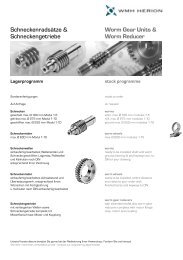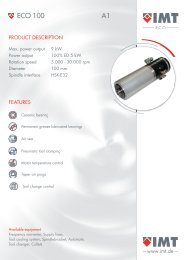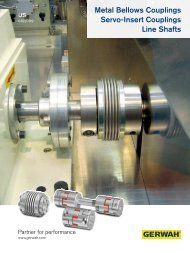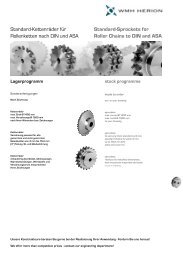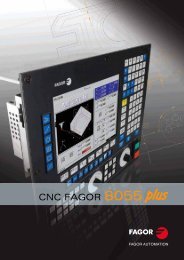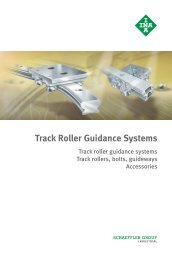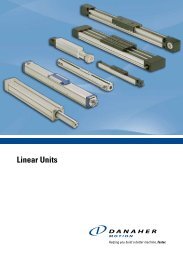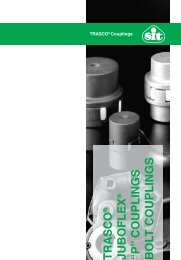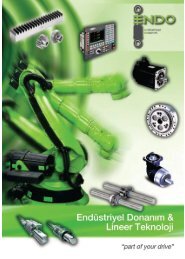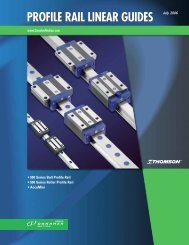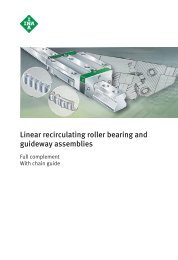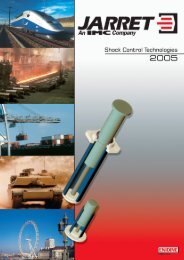slide guide
slide guide
slide guide
You also want an ePaper? Increase the reach of your titles
YUMPU automatically turns print PDFs into web optimized ePapers that Google loves.
SLIDE TABLE<br />
RATED LIFE<br />
SPECIAL REQUIREMENTS<br />
The life of an NB <strong>slide</strong> table is calculated using the following equations.<br />
Rated Life<br />
Life Time<br />
NB can machine tables to meet special requirements, including tables with a micrometer head and tables for<br />
projectors. Please contact NB for details.<br />
L= (<br />
fT<br />
fW ・C P ) 10 / 3・50 Lh= L・10 3<br />
2・lS・n1・60<br />
L: rated life(km) fT: temperature coefficient fW: applied load coefficient<br />
C: basic dynamic load rating(N) P: applied load(N)<br />
※Please refer to page Eng-5 for the coefficients.<br />
Lh: life time (hr) lS: stroke length(m)<br />
n1: number of cycles per minute(cpm)<br />
LOAD RATING<br />
The load rating of the <strong>slide</strong> table NVT type differs depending on the direction of the load.<br />
Table G-6 Change of Load Rating Corresponding to Load Direction<br />
basic dynamic<br />
load rating<br />
basic static<br />
load rating<br />
normal vertical direction<br />
horizontal direction<br />
reverse vertical direction<br />
normal vertical direction<br />
horizontal direction<br />
reverse vertical direction<br />
1.0×C<br />
0.85×C<br />
0.7×C<br />
1.0×CO<br />
0.85×CO<br />
0.7×CO<br />
※There may be a difference depending on the size.<br />
Please contact NB for details.<br />
Consideration has been given to holes for STUDROLLERs<br />
in the raceway surface in calculation of load ratings.<br />
Figure G-19 Direction of Load<br />
reverse vertical direction<br />
normal vertical direction<br />
horizontal direction<br />
USE AND HANDLING PRECAUTIONS<br />
Careful Handling<br />
Dropping the <strong>slide</strong> table causes the rolling elements<br />
to make dents in the raceway surface. This will<br />
prevent smooth motion and will also affect accuracy.<br />
Be sure to handle the product with care.<br />
Dust Prevention<br />
Dust and foreign particles affect the accuracy and<br />
lifetime of a <strong>slide</strong> table. A <strong>slide</strong> table used in a harsh<br />
environment should be protected with a cover.<br />
Lubrication<br />
The <strong>slide</strong> table is prelubricated with lithium soap<br />
based grease prior to shipment for immediate<br />
use. Make sure to relubricate with a similar type<br />
of grease periodically depending on the operating<br />
conditions.<br />
Cage Slippage<br />
The cage can slip under high-speed motion,<br />
unbalanced-loading, and vibrating conditions. It is<br />
suggested that the motion speed of a <strong>slide</strong> table<br />
be kept under 30 m/min under general operating<br />
conditions.<br />
It is recommended that the table be cycled to<br />
perform maximum full stroke several times during<br />
operation. This will allow the roller cage to be<br />
returned to its normal central position.<br />
Adjustment/Installation Screw<br />
The NB <strong>slide</strong> table is adjusted to achieve optimum<br />
accuracy and preload. The adjustment screw and<br />
rail installation screws should be kept untouched.<br />
Allowable Load<br />
The allowable load is a load under which the sum of<br />
elastic deformations of the rolling element and the<br />
raceway in the contact area subject to the maximum<br />
contact stress is small enough to guarantee smooth<br />
rolling movement. When very smooth and highly<br />
accurate linear motion is required, make sure to use<br />
the product within the allowable load.<br />
SLIDE TABLE<br />
G-26 G-27



